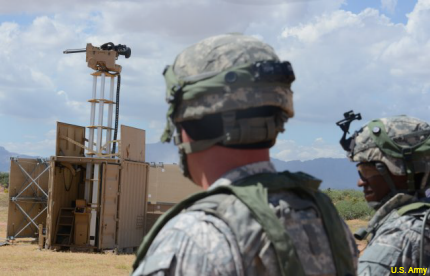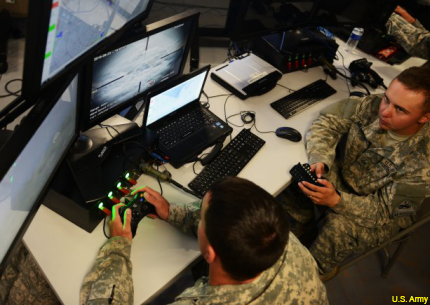Army demos remote system for patrolling base camp perimeter
With multiple weapons systems controlled from a tactical command center, two soldiers can do the job of 10 on patrol

Remotely controlled video and weapons systems protect the camp’s perimeter.
The military has been using technology to make up for reduced manpower or to keep soldiers out of harm’s way for years. Ground robots detect and detonate improvised explosive devices, for example, and could one day retrieve the wounded from the battlefield. Drop-in systems for aircraft could soon reduce the size of flight crews.
Now the Army is taking that approach to base-camp protection, using remotely controlled weapons systems to reduce the number of soldiers required to protect the perimeter.
A typical expeditionary outpost requires four to six soldiers working eight- to 12-hour shifts to man a perimeter weapons system. But with the remote system, being tested at Network Integration Evaluation 16.1 going on at and around Fort Bliss, Texas, two soldiers in a tactical operations center can do the work of 10, the Army said in release.
That frees up troops for other duties. "Every soldier I have assigned to securing the perimeter is one I don't have that can execute support missions," said Lt. Col. Raphael Heflin, commander of the 142nd Combat Service Support Battalion, or CSSB, 1st Armored Division.

Soldiers control multiple weapons systems from inside the tactical operation center.
CSSB uses containerized weapons systems that include expeditionary towers and, in the case at NIE, a Browning M-2 50-caliber machine gun and a 338 Lapua sniper rifle, although just about any gun could be used. Six soldiers can set up each tower in about an hour, said Capt. Robert Scott, officer-in-charge of the 142nd CSSB's base defense operation center. Once set up, soldiers inside the operation center can then control the weapons—raising, lowering or rotating them a full 360 degrees. And, of course, fire them if need be.
Operators control the weapons via Joint All Hazard Command Control System software, and monitor the perimeter with video feeds that include thermal and infrared views—which provide particularly good views at night. If an enemy is detected, the system can plot coordinates to help direct fire from the mounted weapon.
When it’s time to break camp, the components can be quickly put back into their container.
The remote perimeter system is one of many being tested at NIE 16.1, which got underway Sept. 25 and runs through Oct. 8. Hosted by the Army at Fort Bliss and the adjacent White Sands Missile Range and Holloman Air Force Base in New Mexico, it involves about 9,000 participants from all of the U.S. military branches and 14 coalition partners.



